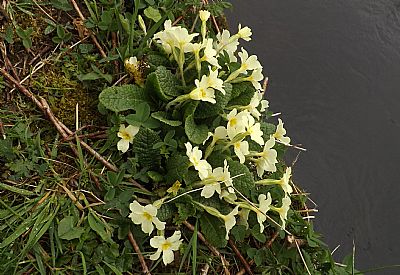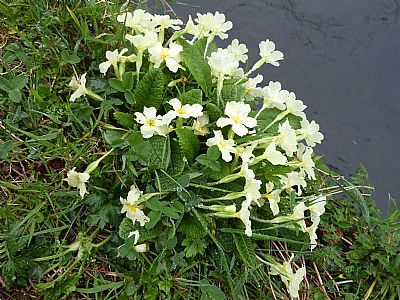PRIMROSES & COWSLIPS : primula
The common primrose is our main native speices of primula, but there are many others, most of which are introduced or hybrids. Those that are native to the UK include oxlip (primula elatior) and cowslip (Primula Veris). The former is rare, but you may come across the latter - much like our common primrose, but with completely yellow flowers. If you find these in West Dunbartonshire, they are most likely to have been introduced, intentionally or in error. And then there is the Scots Primrose (Primula scotica), which is purple.
PRIMROSE : Primula vulgaris
These delightful pale yellow flowers appear in clusters in spring. They are happy under trees where suffcient sunlight filters in. And occasionally find an open spot that meets their approval. In spite of their disappointing Latin name, they are very attractive with soft yellow blooms. Primula or primus simply means prime and vulgaris means common.
It thrive best on nutrient-rich, but lime-poor, humus-rich, loose and often stony loam soils so it is unsurprising to find it along river banks or where cattle have, to put it politely, contributed some enrichment to the soil.

Primroses on the bank of the upper Leven.

As we tip into the glorious 1st days of May, large batches of primroses appear on the river banks again.
COWSLIP : Primula Veris
Although also primula, they differ from what we normally think of as "primroses" in that their flowers are bell-shaped. It is the type of flower that we probably all find attractive and familiar yet tend to envisage it in amongst many others as small highlights of yellow on stalks. Each bright yellow flower has five petals with small indents on the top edge of each petal. They are enclosed by a long, green, tube-shaped calyx (protective flower casing) and are found in clusters on each plant, all facing to one side. They can be found in meadows, grassland, woodland and verges as well as in gardens. They thrive on dry, calcareous (chalky) soils and flower between April and May.
The name ‘cowslip’ comes from ‘cow slop’. (No, not cow's lip). As we noted with primroses, these primula enjoy earth enriched by cows, in other words by their manure created from cow pats and can therefore be found in fields or open woodland where cows have access.
The plant was traditionally used to treat sleeping problems as it is said to have a sedative quality, as well as the flowers being used to help treat coughs.
The National Records of Scotland tell us that the flowers of this native plant have been used to flavour wine and make medicinal ointments and creams to improve complexion, memory and sunburn for a long time.
And quote from Robert Burns's song 'The Lass of Cessnock Banks' which celebrates his love for Alison Begbie, the daughter of a farmer from the Parish of Galston who turned down his request for marriage in 1781-82 -
She is stately like yon youthful ash,
That grows the cowslip braes between...
It also appears in his 'Elegy on Captain Mathew Henderson' -
Mourn, Spring, thou darling of the year!
Ilk cowslip cup shall kep a tear.
This section is naturally being written as primroses and cowslips come into flower. So on the 1st of May, Mayday, some witchcraft appeared in my Google search list. This was entitled Celebrating the Cowslip on May Day morning in the witch’s garden and written by Todd Atteberry on his Witchery Arts blog. In it he notes that cowslip is a staple of British folklore, herbalism and literature.
His first example is from William Shakespeare's A Midsummer’s Night Dream
And I serve the Fairy Queen
To dew her orbs upon the green.
The cowslips tall her pensioners be.
In their gold coats spots you see;
Those be rubies, fairy favours;
In those freckles live their savours.
I must go seek some dewdrops here,
And hang a pearl in every cowslip’s ear.
If your interest in the mystical associations with cowslip have been pricked have a look at that blog - see the link below. It covers further literary extracts and quite a bit on its use in herbal remedies. Many plants were certainly considered very useful for their medicinal properties, but cowslip seems to be imbued with quite a range of benefits.
Cowslips were also used in various traditional activities such as the making of tissty-tossties, a decorative ball of blooms used in games and superstitions such as telling of the future. This could simply be who they would be married to or even their occupation while tossing them and reciting ‘Rich man, poor man, beggar man, farmer, tinker, tailor, ploughboy, thief’. Gertrude Jekyll, in her Children & Gardens (1908), described how these were made.
Cowslips were traditionally picked on May Day to adorn garlands but also for other celebrations, such as weddings. Cowslips have also been called ‘St. Peter’s keys’ or ‘keys of heaven’ because the one-sided flower heads looked like a set of keys, and it was said that cowslips grew where St. Peter dropped the Key of Earth.
(The cowslip may have plenty of May connotations, but is not the mayflower which is a low trailing flower related to hawthorn).
EVERYDAY NATURE TRAILS : https://theresagreen.me/
NATIONAL RECORDS OF SCOTLAND : https://www.nrscotland.gov.uk/research/archivists-garden/index-by-plant-name/cowslip
PLANT LORE : https://www.plant-lore.com/plantofthemonth/tissty-tossties/
WIKIPEDIA : https://en.wikipedia.org/wiki/Primula_vulgaris
THE WITCHERY ARTS including Celebrating the Cowslip on May Day morning in the witch’s garden and written by Todd Atteberry : https://www.gothichorrorstories.com/witches-garden/witch-garden-feature/witches-garden-plants/celebrating-the-cowslip-on-may-day-morning-in-the-witchs-garden/
WOODLAND TRUST : https://www.woodlandtrust.org.uk/trees-woods-and-wildlife/plants/wild-flowers/primrose/ & https://www.woodlandtrust.org.uk/trees-woods-and-wildlife/plants/wild-flowers/cowslip/

